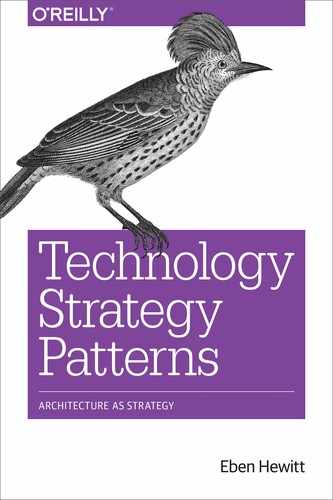Chapter 10. Bringing It All Together
Patterns Map
This completes the discussion of our 39 patterns. Now that you have a good understanding of each individual pattern, let’s look at them all (well, all the creation and communication patterns, anyway) together in a map. When viewed all at once, the patterns in this book are devised to work on three levels:
- Individually
-
For many of the patterns, you can just implement one pattern on its own and get real value from it. The Architecture Definition (see “Architecture Definition”) is a great example of this; you can write an architecture for a specific new project you’re undertaking, and that would be very useful on its own. And in a different context, the SWOT (see “SWOT”), Technology Radar (see “Technology Radar”), and APM (“Application Portfolio Management”) are great to use alone too, depending on your need and your audience. So feel free to do that. On the other hand, some of them, such as the Investment Map, might not be as fully realized if approached in a vacuum. And then there is no value really in doing a Ghost Deck (see “Ghost Deck”) by itself—its value is in helping structure the other kinds of major decks, such as the Strategy Deck and Ask Deck (so that’s why it’s represented twice in Figure 10-1).

Figure 10-1. How all the patterns fit and flow together
- In clusters
-
You can alternatively use several patterns together in clusters of three or five, if you have a medium-scope problem that is contained to the technology side or the business/operating model side. For example, if you’re doing a broad industry analysis, you can pick patterns from Chapter 4 and use those to make a strategy recommendation. Or your marketing or product management department may have already created analyses for you to use as world and industry context and you’re not interested in that; you might instead just need to do the technology work. In this case, you could use only the Build/Buy/Partner pattern (see “Build/Buy/Partner”), Use Case Map (see “Use Case Map”), Architecture Definition (see “Architecture Definition”), and Due Diligence (see “Due Diligence”). If you have a clear idea of what your technical pursuit is already, you might be more focused on this occasion on the project-oriented cluster: the Stakeholder Alignment pattern (see “Stakeholder Alignment”), Roadmap (see “Roadmap”), Directional Costing (see “Directional Costing”), and Tactical Plan (see “Tactical Plan”).
- Comprehensively
-
Finally, you could use the patterns all together. If you do this, it’s almost certainly for one of two main reasons: to create a broad organizational strategic plan leading up to a Strategy Deck (see “Strategy Deck”), or in order to create an Ask Deck (see “Ask Deck”). In one sense, these are the most important patterns here, inasmuch as they’re the two that all the others exist to serve. It’s the way you get funded, and to make a good Ask Deck, you really have to do many of the other patterns first.
The map of how they all work together is shown Figure 10-1. This can give you a sense of how they might flow or depend on each other. You can see how they cluster in a few smaller groups as well.
How many of them you implement depends, of course, on the size, expense, novelty, risk, and complexity of your project.
I submit that architects (and technology managers and practitioners) can move up the value chain, and help their companies to compete and differentiate, if they spend less time policing developers and more time visiting each of the boxes on this map and executing these patterns as discussed throughout this book. Use the results of these patterns to work more closely and meaningfully with your partners in product management, sales, business development, and strategy.
Conclusion
That’s it! Thank you so much for reading this book. I really hope you enjoyed it and that you found it useful. We’ve come a long way together and covered amazing ground. There is so much more to say on these topics. But my hope is that, in having read this book, you now have greater awareness of—as David Foster Wallace might call it—the “water,” the context in which we work as technology strategists. I hope too that you now feel greater mastery of the art of creating power for you and your organization, and you see how these tools can considerably improve your ability to differentiate and compete in a crowded market.
As you advance in your career, remember that these waters never stand still: different patterns will make sense for you and your teams at different times, and you’ll need to frequently adjust. It may seem daunting, but I promise you: the tools and strategies presented in this text will help you navigate deftly through this exciting, challenging, fabulous ocean.
I’ll leave you with these parting words:
The whole interest of reason, speculative as well as practical, is centered in the three following questions:
What can I know?
What ought I to do?
What may I hope?
18th century German philosopher Immanuel Kant, The Critique of Pure Reason
Thoughts are things.
Bruce Lee
Best wishes, my friends.
